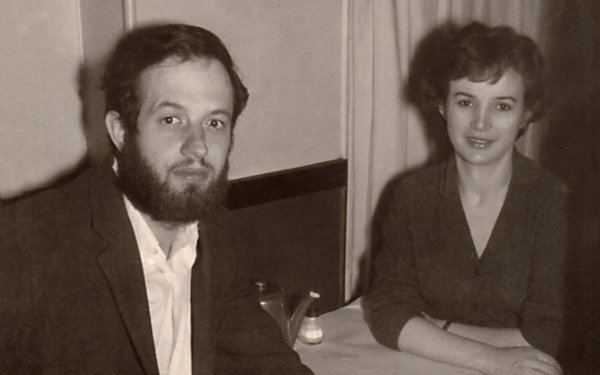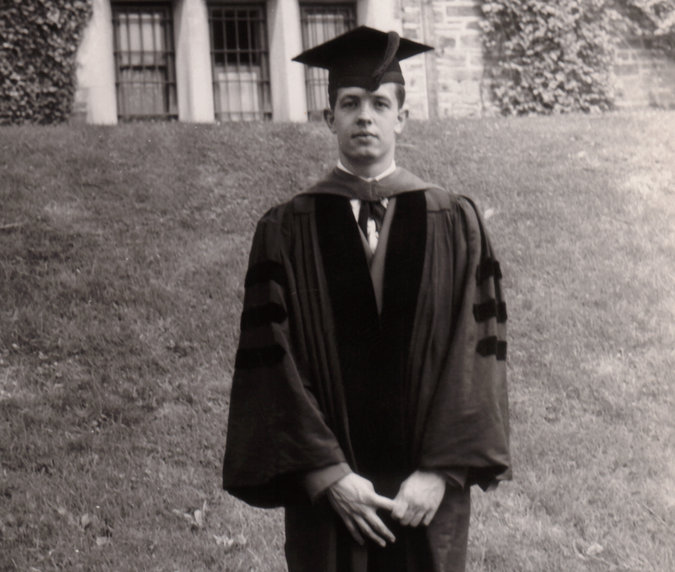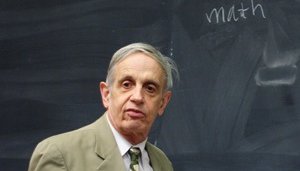John F. Nash Jr., Math Genius Defined by a ‘Beautiful Mind,’ Dies at 86
SPOTLIGHT, 1 Jun 2015
Erica Goode – The New York Times
John F. Nash Jr., a mathematician who shared a Nobel Prize in 1994 for work that greatly extended the reach and power of modern economic theory and whose long descent into severe mental illness and eventual recovery were the subject of a book and a film, both titled “A Beautiful Mind,” was killed, along with his wife, in a car crash on Saturday [23 May 2015] in New Jersey. He was 86.
Dr. Nash and his wife, Alicia, 82, were in a taxi on the New Jersey Turnpike in Monroe Township around 4:30 p.m. when the driver lost control while veering from the left lane to the right and hit a guardrail and another car, Sgt. Gregory Williams of the New Jersey State Police said.
The couple were ejected from the cab and pronounced dead at the scene. The State Police said it appeared that they had not been wearing seatbelts. The taxi driver and the driver of the other car were treated for injuries. No criminal charges had been filed on Sunday.
The Nashes were returning home from the airport after a trip to Norway, where Dr. Nash and Louis Nirenberg, a mathematician from New York University, had received the Abel Prize from the Norwegian Academy of Science and Letters.

Dr. Nash and his wife, Alicia, in Paris in 1960. By then, mental illness had begun to take its toll on him. Though the couple divorced in 1963, she stood by him, and they later remarried.
Dr. Nash was widely regarded as one of the great mathematicians of the 20th century, known for the originality of his thinking and for his fearlessness in wrestling down problems so difficult that few others dared tackle them. A one-sentence letter written in support of his application to Princeton’s doctoral program in math said simply, “This man is a genius.”
“John’s remarkable achievements inspired generations of mathematicians, economists and scientists,” the president of Princeton, Christopher L. Eisgruber, said on Sunday, “and the story of his life with Alicia moved millions of readers and moviegoers, who marveled at their courage in the face of daunting challenges.”
Russell Crowe, who portrayed Dr. Nash in the 2001 film adaptation of “A Beautiful Mind,” posted on Twitter that he was “stunned” by the deaths. “An amazing partnership,” he wrote. “Beautiful minds, beautiful hearts.”
Dr. Nash’s theory of noncooperative games, published in 1950 and known as Nash equilibrium, provided a conceptually simple but powerful mathematical tool for analyzing a wide range of competitive situations, from corporate rivalries to legislative decision-making. Dr. Nash’s approach is now pervasive in economics and throughout the social sciences and applied in other fields as well, including evolutionary biology.
Harold W. Kuhn, an emeritus professor of mathematics at Princeton and a longtime friend and colleague of Dr. Nash’s who died in 2014, once said, “I think honestly that there have been really not that many great ideas in the 20th century in economics, and maybe, among the top 10, his equilibrium would be among them.” A University of Chicago economist, Roger Myerson, went further, comparing the impact of the Nash equilibrium on economics “to that of the discovery of the DNA double helix in the biological sciences.”
Dr. Nash also made contributions to pure mathematics that many mathematicians view as more significant than his Nobel-winning work on game theory. In one he solved an intractable problem in differential geometry derived from the work of the 19th century mathematician G. F. B. Riemann.
His achievements were the more remarkable, colleagues said, for being presented in papers published before he was 30.
“Jane Austen wrote six novels,” said Barry Mazur, a professor of mathematics at Harvard who was a freshman at M.I.T. when Dr. Nash taught there. “I think Nash’s pure mathematical contributions are on that level. Very, very few papers he wrote on different subjects, but the ones that had impact had incredible impact.”
To a wider audience Dr. Nash was probably best known for his life story, one of dazzling achievement, devastating loss and almost miraculous redemption. The tale of Dr. Nash’s brilliant rise, the years lost to schizophrenia, his return to rationality and his receiving the Nobel — retold in a biography by Sylvia Nasar and in the Oscar-winning film, which also starred Jennifer Connelly as Alicia Nash — captured the public mind as a portrait of the destructive force of mental illness and the stigma that can hound those who suffer from it.
Arrogant, Ambitious and Odd
John Forbes Nash was born on June 13, 1928, in Bluefield, W.Va. His father, John Sr., was an electrical engineer. His mother, Margaret, was a Latin teacher.
As a child, John Nash may have been a prodigy, but he was not a sterling student, Ms. Nasar noted in a 1994 article in The New York Times. “He read constantly. He played chess. He whistled entire Bach melodies,” she wrote.
In high school he stumbled across E. T. Bell’s book “Men of Mathematics,” and soon demonstrated his own mathematical skill by independently proving a classic Fermat theorem, an accomplishment he recalled in an autobiographical essay written for the Nobel committee.
Intending to become an engineer like his father, he entered Carnegie Mellon University (then called Carnegie Institute of Technology) in Pittsburgh. But he chafed at the regimentation of the coursework and switched to mathematics, encouraged by professors who recognized his mathematical genius.
Receiving his bachelor’s and master’s degrees from Carnegie, he arrived at Princeton in 1948. It was a time of great expectations, when American children still dreamed of growing up to be physicists like Einstein or mathematicians like the brilliant Hungarian-born polymath John von Neumann, both of whom attended the afternoon teas at Fine Hall, the home of the math department.
John Nash, tall and good-looking, became known for his intellectual arrogance, his odd habits — he paced the halls, walked off in the middle of conversations and whistled incessantly — and his fierce ambition, his colleagues have recalled.
He invented a game, known as Nash, that became an obsession in the Fine Hall common room. (The same game, invented independently in Denmark, was later sold by Parker Brothers as Hex.) He also took on a problem left unsolved by Dr. von Neumann and Oskar Morgenstern, the pioneers of game theory, in their now-classic book, “Theory of Games and Economic Behavior.”
Dr. von Neumann and Dr. Morgenstern, an economist at Princeton, addressed only so-called zero-sum games, in which one player’s gain is another’s loss. But most real-world interactions are more complicated; players’ interests are not directly opposed, and there are opportunities for mutual gain. Dr. Nash’s solution, contained in a 27-page doctoral thesis he wrote when he was 21, provided a way of analyzing how each player could maximize his benefits, assuming that the other players would also act to maximize their self-interest.
This deceptively simple extension of game theory paved the way for economic theory to be applied to an array of situations besides the marketplace.

Russell Crowe as Dr. Nash in “A Beautiful Mind,” which won the Oscar for best picture. Credit Eli Reed/Universal Studios
“It was a very natural discovery,” Dr. Kuhn said. “A variety of people would have come to the same results at the same time, but John did it and he did it on his own.”
Brilliance Turns Malignant
After receiving his doctorate at Princeton, Dr. Nash worked as a consultant to the RAND Corporation and as an instructor at M.I.T. while continuing to attack problems that no one else could solve. On a dare, he developed an entirely original approach to a longstanding problem in differential geometry, showing that abstract geometric spaces called Riemannian manifolds could be squished into arbitrarily small pieces of Euclidean space.
As his career flourished and his reputation grew, however, Dr. Nash’s personal life became increasingly complex. A turbulent romance in Boston with a nurse, Eleanor Stier, resulted in the birth of a son, John David Stier, in 1953. Dr. Nash also had a series of relationships with men, and while at RAND in the summer of 1954 he was arrested in a men’s bathroom for indecent exposure, according to Ms. Nasar’s biography. And doubts about his accomplishments gnawed at him: Two of mathematics’ highest honors, the Putnam Competition and the Fields Medal, had eluded him.
In 1957, after two years of on-and-off courtship, he married Alicia Larde, an M.I.T. physics major from an aristocratic Central American family and one of only 16 women in the class of 1955.
“He was very, very good looking, very intelligent,” Ms. Nash told Ms. Nasar. “It was a little bit of a hero-worship thing.”
But early in 1959, with his wife pregnant with their son, John, Dr. Nash began to unravel. His brilliance turned malignant, leading him into a landscape of paranoia and delusion, and in April he was hospitalized at McLean Hospital, outside Boston, sharing the psychiatric ward with, among others, the poet Robert Lowell.
It was the first step of a steep decline. There were more hospitalizations. Dr. Nash underwent electroshock therapy and fled for a while to Europe, sending cryptic postcards to colleagues and family members. For many years he roamed the Princeton campus, a lonely figure scribbling unintelligible formulas on the same blackboards in Fine Hall on which he had once demonstrated startling mathematical feats.
Though game theory was gaining in prominence, and his work cited ever more frequently and taught widely in economics courses around the world, Dr. Nash had vanished from the professional world.
“He hadn’t published a scientific paper since 1958,” Ms. Nasar wrote in the 1994 Times article. “He hadn’t held an academic post since 1959. Many people had heard, incorrectly, that he had had a lobotomy. Others, mainly those outside of Princeton, simply assumed that he was dead.”
Indeed, Dr. Myerson recalled in a telephone interview that one scholar who wrote to Dr. Nash in the 1980s to ask permission to reprint an article received the letter back with one sentence scrawled across it: “You may use my article as if I were dead.”
Reaching a ‘Watershed’
Still, Dr. Nash was fortunate in having family members, colleagues and friends who protected him, got him work and in general helped him survive. Ms. Nash divorced him in 1963, but continued to stand by him, taking him into her house to live in 1970. (The couple married a second time in 2001.)
Ms. Nash supported her ex-husband and her son by working as a computer programmer, with some financial help from family, friends and colleagues.
By the early 1990s, when the Nobel committee began investigating the possibility of awarding Dr. Nash its memorial prize in economics, his illness had quieted. He later said that he had simply decided that he was going to return to rationality. “I emerged from irrational thinking, ultimately, without medicine other than the natural hormonal changes of aging,” he wrote in an email to Dr. Kuhn in 1996.
Colleagues, including Dr. Kuhn, helped persuade the Nobel committee that Dr. Nash was well enough to accept the prize — he shared it with two economists, John C. Harsanyi of the University of California at Berkeley, and Reinhard Selten of the Rheinische Friedrich-Wilhelms University in Bonn, Germany — and they defended him when some questioned giving the prize to a man who had suffered from a serious mental disorder.
The Nobel, the publicity that attended it and the making of the film were “a watershed in his life,” Dr. Kuhn said of Dr. Nash. “It changed him from a homeless unknown person who was wandering around Princeton to a celebrity, and financially it put him on a much better basis.”
Dr. Nash is survived by his sons, John David Stier and John Charles Martin Nash, and a sister, Martha Nash Legg.
He continued to work, traveling and speaking at conferences and trying to formulate a new theory of cooperative games. Friends described him as charming and diffident, socially awkward, a little quiet, with scant trace of the arrogance of his youth.
“You don’t find many mathematicians approaching things this way now, barehandedly attacking a problem,” the way Dr. Nash did, Dr. Mazur said.
__________________________________
Correction: May 24, 2015
An earlier version of this obituary misstated the title of a book by E.T. Bell. It is “Men of Mathematics,” not “Men and Mathematics.” It also misstated the poet with whom Dr. Nash spent time in the psychiatric ward at McLean Hospital. It was Robert Lowell, not Ezra Pound.
Michael Schwirtz and Ashley Southall contributed reporting.
A version of this article appears in print on May 25, 2015, on page A1 of the New York edition with the headline: John Nash, 86, Math Genius Defined by a ‘Beautiful Mind,’ Dies.
DISCLAIMER: The statements, views and opinions expressed in pieces republished here are solely those of the authors and do not necessarily represent those of TMS. In accordance with title 17 U.S.C. section 107, this material is distributed without profit to those who have expressed a prior interest in receiving the included information for research and educational purposes. TMS has no affiliation whatsoever with the originator of this article nor is TMS endorsed or sponsored by the originator. “GO TO ORIGINAL” links are provided as a convenience to our readers and allow for verification of authenticity. However, as originating pages are often updated by their originating host sites, the versions posted may not match the versions our readers view when clicking the “GO TO ORIGINAL” links. This site contains copyrighted material the use of which has not always been specifically authorized by the copyright owner. We are making such material available in our efforts to advance understanding of environmental, political, human rights, economic, democracy, scientific, and social justice issues, etc. We believe this constitutes a ‘fair use’ of any such copyrighted material as provided for in section 107 of the US Copyright Law. In accordance with Title 17 U.S.C. Section 107, the material on this site is distributed without profit to those who have expressed a prior interest in receiving the included information for research and educational purposes. For more information go to: http://www.law.cornell.edu/uscode/17/107.shtml. If you wish to use copyrighted material from this site for purposes of your own that go beyond ‘fair use’, you must obtain permission from the copyright owner.


I greatly admire Mr. Nash as an early theorist of game theory and in his struggle against his illness. And I am very sorry about his death.
Therefore I want to add 2 remarks here:
1) A “Nash Equilibrium” unfortunately is NOT a good thing. It is the very suboptimal state 2 players lock themselves into because they cannot unilaterally find a better strategy.
2) “Indecent exposure” is not the worst thing one can do at the RAND corporation. They were an USAF think tank developing strategies for WMD use.
Yours
Werner T. Meyer